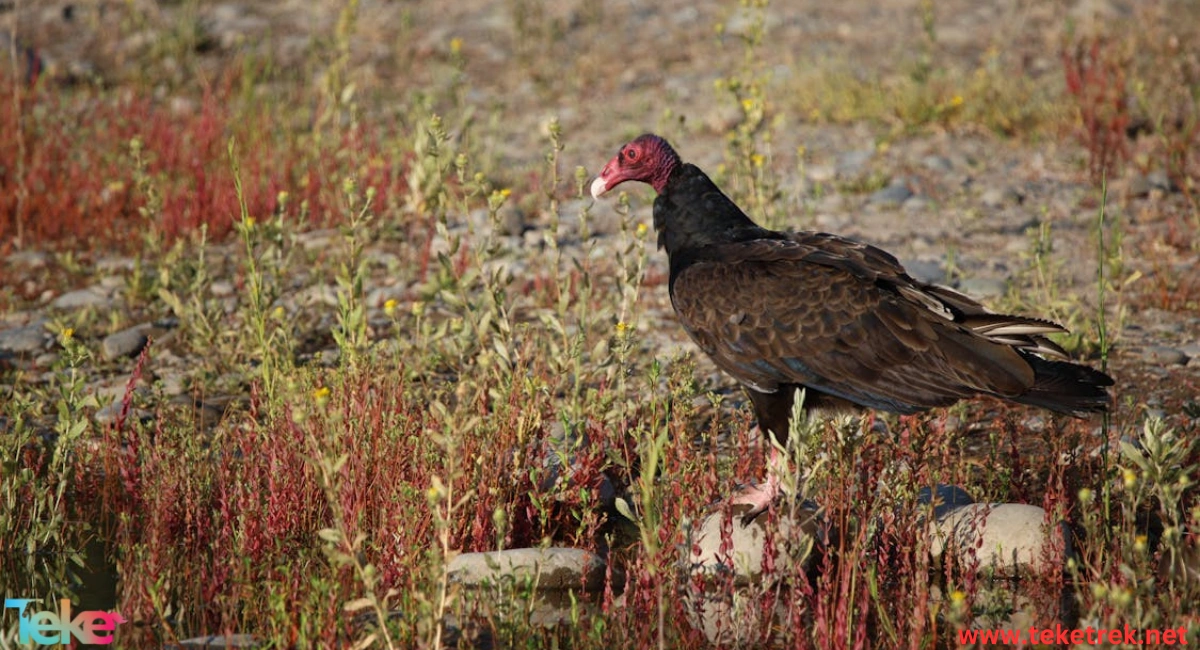The red-headed vulture got its name from the presence of a large red spot of bare skin on its head and neck.
In the following article from teketrek, we will talk about the red-headed vulture and learn about its diet, characteristics and method of reproduction.

What are the characteristics of the red-headed vulture?
The red-headed vulture belongs to the Animalia kingdom, the Chordata division, the Aves class, the Accipitridae family, the Aves class, and its scientific name is “Sarcogyps calvus”.
It is a medium-sized vulture with a length of 76 to 86 cm, a weight of 3.5-6.3 kg, and a wingspan of about 1.99-2.6 m.
The Red-headed Vulture has a prominent bare head that is dark red to orange in adults and pale red in juveniles.
The Red-headed Vulture has a black body with a pale gray band at the base of the flight feathers.
The Red-headed Vulture lacks feathers on its neck, chin, thighs, and legs, which appear in a bright red color.
The Red-headed Vulture also has distinctive white spots on its thighs and chest, making it one of the vultures that are easy to identify.
Adult males have white (or pale) eyes.
Adult females have dark eyes.
Where does the Red-headed Vulture live?
The Red-headed Vulture is found in most parts of the Indian subcontinent and other parts of South Asia, including Pakistan, China, Tibet, Laos, and Vietnam.
The Red-headed Vulture is most often found in open areas, wooded hills, dry deciduous forests, or river valleys, as well as in deserts, wetlands, and hill slopes, which usually do not exceed an altitude of 2500 – 3000 meters above sea level.
Like most vultures, the Red-headed Vulture does not make many sounds but prefers to sit or fly in silence while watching the world around it or searching for food. However, when it wants to, it will croak and hiss when in a fight with another vulture for the first bites of the carcass.
What is the red-headed vulture diet?
The Red-headed Vulture is a carnivore that mostly feeds on carrion, meaning it eats animals that are already dead. Its diet mostly consists of the carcasses of large cattle, as well as deer and even jackals.
It has also been observed that the Red-headed Vulture kills birds that are already injured and fish stranded on the shore.
Like all vultures, the Red-headed Vulture has very little feathering on its head, so when it eats, it often needs to put its head into the cavities of rotting carcasses.
If particles of this flesh were to get into its feathers, it could cause bacteria or germs to grow. Although some people might think that vultures look ugly, the truth is that the bald head helps keep vultures healthy, and the healthier the vultures are, the better.
As the Red-headed Vulture is considered nature’s cleanup crew, vultures and other scavengers often consume living organisms in dead and decomposing animals that harm humans and the environment.
Breeding stages of the Red-headed Vulture:
The Red-headed Vulture builds its nest in the crowns of tall trees.
In areas where there are no tall trees, it resorts to building its nests in acacia bushes or thorny shrubs.
Both the male and female build their nest using available sticks and branches.
Once the nest is built, the pair line it with grass, fur, wool, and other similar materials.
When the pair builds a nest for the first time, it is usually relatively small, but over the years, the pair will make additions and repairs to the nest.
Eventually, it will grow to become a very large structure, and it can be more than one meter wide.
When the right time comes, the female Red-headed Vulture usually lays a large white egg. Just as with building the nest, both the male and female Red-headed Vulture share incubation duties, taking turns sitting on the egg for about two months.
Once the chick hatches, the male and female also take turns brooding their young for up to another two months.
The male and female take care of their young and ensure they are kept at the right temperature, not too hot and not too cold, so they can grow into a healthy chick.
However, for the chick to grow, it also needs to eat well and consume a lot of food.
The parents must work hard to ensure their young get enough sustenance.
The diet of the young vulture consists entirely of regurgitated food until it is old enough to feed itself.
After about 4-5 months, the young vulture fledges or flies for the first time.

Frequently Asked Questions about the Red-headed Vulture:
- What does the Red-headed Vulture feed on?
The Red-headed Vulture feeds on carrion and dead animals.
- Where can we find the Red-headed Vulture in abundance?
It is mainly found in the Indian subcontinent, with some isolated vultures in parts of Southeast Asia.
- Is the Red-headed Vulture considered endangered?
The Red-headed Vulture has been classified as critically endangered by the International Union for Conservation of Nature (IUCN) due to a sharp decline in its numbers.
- What are the main threats faced by the Red-headed Vulture?
One of the main reasons for the decline in its numbers is the use of the non-steroidal anti-inflammatory drug diclofenac in veterinary medicine in India, which is known to be very toxic to vultures.
Why are red headed vulture endangered in India?
Due to biotic and abiotic factors including: habitat loss, predation, hunting, food and wat
In conclusion, in 2004, this species was listed as endangered with the least concern by the International Union for Conservation of Nature. However, the widespread use of non-steroidal anti-inflammatory drugs like diclofenac in veterinary medicine in India has led to a collapse in its numbers in recent years. Diclofenac is now known to be highly toxic to vultures.





